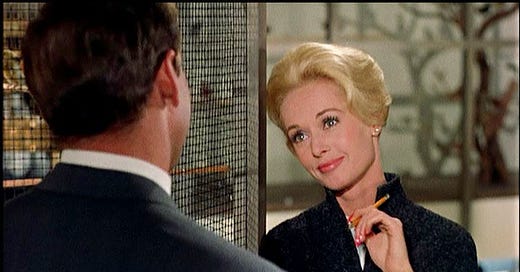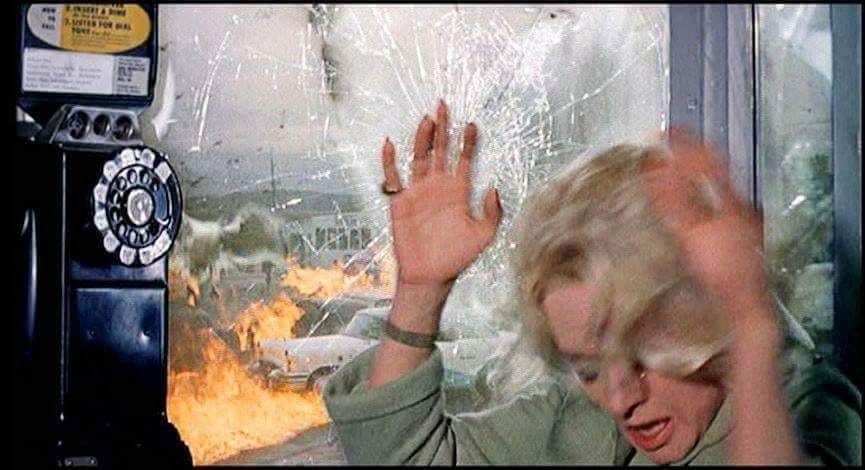Marnie. The Birds. ‘Tippi’ (don’t forget the apostrophes, kids!)
Let us dive into the complete and total ‘Tippi’ Hedren experience: The gulls smashing against the glass phone booth in The Birds. The weathered look of the backdrop, the steel-toned palette, the pink flesh vivid against the blues — all bring mid-century Hitchcock thrillingly back to life.
The phone booth scene is a master class in ‘Tippi’ Hedren. Seeing her swirling about in the tight glass enclosure is to realize how exquisitely arch, how elegantly posed and contrived her performance is. And this is exactly what Hitchcock wanted.
After Grace Kelly deserted the director (as he surely saw it) for marriage to a minor princeling (Hitchcock was notorious for unhealthy infatuations with his leading ladies), the great director decided he wanted nothing more to do with stars if he could help it.
Stars came with built-in associations, the baggage of past roles. They were vibrant personas that connected with audiences. Hitchcock, however, was picking up something new in the air. He wanted something radical:
Stars who didn’t connect… stars who conveyed a modern isolation.
The director now pointedly chose actresses who had a tendency to appear wooden and uninflected on the screen — limited actresses whose hollow resonances helped define his particular kind of morally vague blonde: Soulless, blank-eyed (think of Janet Leigh driving in Psycho ), they were embodiments of modern anomie, of existential emptiness.
Hitchcock’s mid-century blondes have one other signature feature: they are without warmth. Think of the sleekly cool Eva Marie Saint in North by Northwest … available but so fashionably uninvolved. The shell-shocked Janet Leigh in Psycho, for whom the violins must scream for she can not as she mutely slips and slides down the wall during the shower murder. Even Kim Novak, a sensual, romantic screen presence, all soft curves and burry voice, is transformed by Hitchcock into something remote in Vertigo, more than remote, someone almost supernatural.
And so we come to the superior vacancy of ‘Tippi’ Hedren. Hedren is Hitchcock’s most minimalist actress, one who conveyed emotions by her rate of blinking. When she is under mass attack in The Birds, she simply blinks more fiercely.
In many scenes, in fact, with the high bluff of her hair and cocked head, she resembles a bird, scrutinizing, first this way then that, the world outside her gilded cage.
In Marnie, even the blinking disappears, and we are confronted by stark white-eyed staring, a frozen straight-forward glare even as she is overwhelmed by red suffusions and suppressed memories, even as she is taken by force by a Sean Connery in his prime, who has blackmailed her into a loveless marriage and then broken his promise about the loveless part.
One of the persistent questions in The Birds is why the birds attack the humans in the first place. Hitchcock gives no reason, allowing audiences to shift uneasily in their seats as the screen is clawed into chaos. The film’s finale, with ‘Tippi’ and company inching gingerly toward a gull-covered convertible, with its fragile canvas roof, captures the jittery tempo of the paranoid, post-atomic 1960s, an unresolved ending that remains cooly modern and radical: Things happen. For no reason. Deal with it.
And I, after many viewings, have dealt with it. You see I do know the reason why the birds attack: And her name is ‘Tippi’. Regal, blond, envelope thin, ‘Tippi’ Hedren in The Birds is a creature of high-fashion artifice, of the elegant long neck and uncomfortable twisted positions favored by the Vogue photographer. An artifice so thorough that nature is thrown into an uproar, a rage, and rises to attack her.
As a smug, soulless playgirl, the Hedren character is the alien invader come to pastoral Bodega Bay. She is threat and competitor. Her contrived angularity — the steel-glass metropolis personified — vies for the mantle of ultimate beauty, offering something more austere and machine-made than the organic, messy circles of coastal nature.
And so she must be stopped, and the gulls swoop down, in a famous sky-high shot, to rip her apart with talon and beak, banging with maddened frenzy into the glass phone booth where she has taken shelter, cracking the glass, setting off gasoline fires, exploding cars, wild runaway horses — a sly and never-to-be-forgotten Hitchcockian tableau of an ecological apocalypse.
And by riding out the attack, whirling in her glass phone booth, ‘Tippi’ remains a haunting presence in the imagination. Talk all you want about great acting, about actors disappearing into their roles. An impression is made, indelible and somewhat thrilling, when we light a cigarette with ‘Tippi’ in her tailored green suit and sit beside the playground… as the crows gather behind us in billowing blackness.
Screencaps, via YouTube1 and YouTube2: The Birds, 1963, Universal Pictures
DVD available on Amazon
Yours truly,









Nice article John, thank you!
Yes, a fascinating thing Hitchcock's women are. I do think Tippi wins the award. Always glad we didn't see her in that nightgown Pleshette let her borrow and she stayed in the suit. I love the scene is the Pet store and a glimpse of SF, just as I love watching Leigh in Psycho before she takes the shower. Great writing.